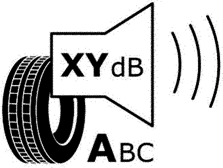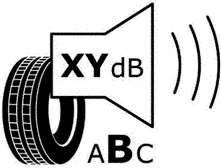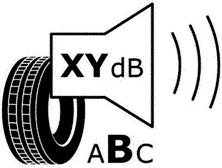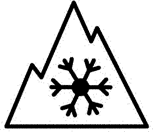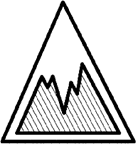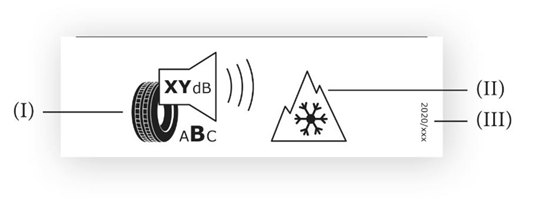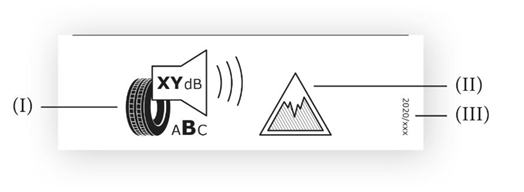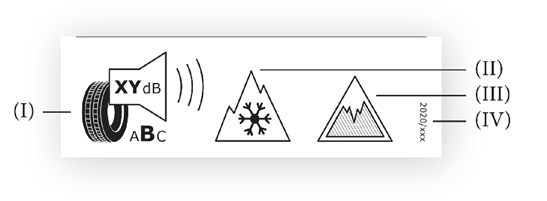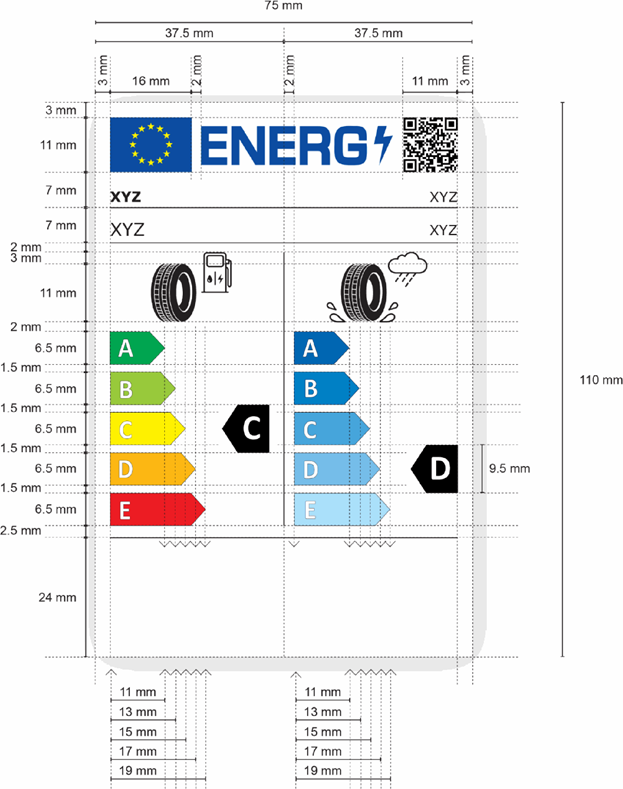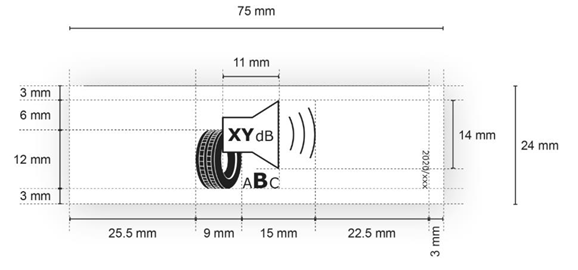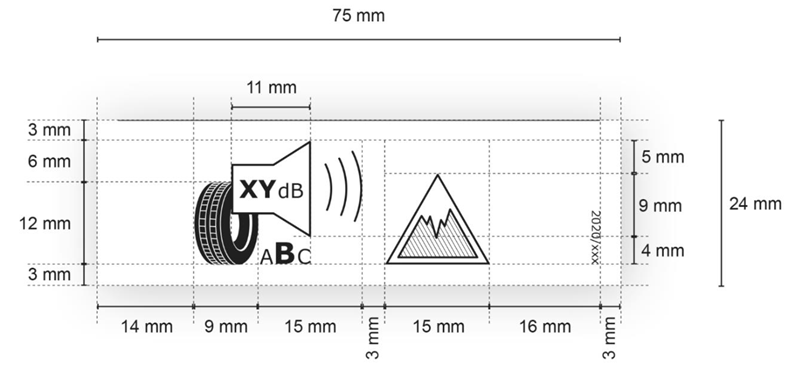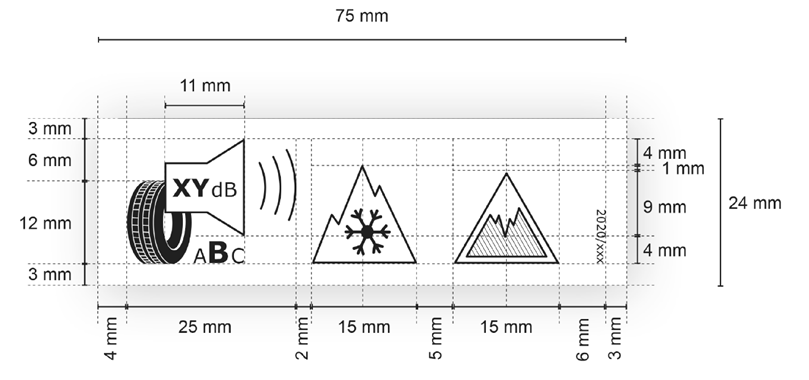- Y Diweddaraf sydd Ar Gael (Diwygiedig)
- Pwynt Penodol mewn Amser (25/05/2020)
- Gwreiddiol (Fel y’i mabwysiadwyd gan yr UE)
Regulation (EU) 2020/740 of the European Parliament and of the CouncilDangos y teitl llawn
Regulation (EU) 2020/740 of the European Parliament and of the Council of 25 May 2020 on the labelling of tyres with respect to fuel efficiency and other parameters, amending Regulation (EU) 2017/1369 and repealing Regulation (EC) No 1222/2009
You are here:
- Rheoliadau yn deillio o’r UE
- 2020 No. 740
- Annexes only
- Dangos Graddfa Ddaearyddol(e.e. Lloegr, Cymru, Yr Alban aca Gogledd Iwerddon)
- Dangos Llinell Amser Newidiadau
Rhagor o Adnoddau
PDF o Fersiynau Diwygiedig
- ddiwygiedig 05/06/20200.60 MB
When the UK left the EU, legislation.gov.uk published EU legislation that had been published by the EU up to IP completion day (31 December 2020 11.00 p.m.). On legislation.gov.uk, these items of legislation are kept up-to-date with any amendments made by the UK since then.
Mae hon yn eitem o ddeddfwriaeth sy’n deillio o’r UE
Mae unrhyw newidiadau sydd wedi cael eu gwneud yn barod gan y tîm yn ymddangos yn y cynnwys a chyfeirir atynt gydag anodiadau.Ar ôl y diwrnod ymadael bydd tair fersiwn o’r ddeddfwriaeth yma i’w gwirio at ddibenion gwahanol. Y fersiwn legislation.gov.uk yw’r fersiwn sy’n weithredol yn y Deyrnas Unedig. Y Fersiwn UE sydd ar EUR-lex ar hyn o bryd yw’r fersiwn sy’n weithredol yn yr UE h.y. efallai y bydd arnoch angen y fersiwn hon os byddwch yn gweithredu busnes yn yr UE. EUR-Lex Y fersiwn yn yr archif ar y we yw’r fersiwn swyddogol o’r ddeddfwriaeth fel yr oedd ar y diwrnod ymadael cyn cael ei chyhoeddi ar legislation.gov.uk ac unrhyw newidiadau ac effeithiau a weithredwyd yn y Deyrnas Unedig wedyn. Mae’r archif ar y we hefyd yn cynnwys cyfraith achos a ffurfiau mewn ieithoedd eraill o EUR-Lex. The EU Exit Web Archive legislation_originated_from_EU_p3
Status:
Point in time view as at 25/05/2020.
Changes to legislation:
There are currently no known outstanding effects for the Regulation (EU) 2020/740 of the European Parliament and of the Council.![]()
Changes to Legislation
Revised legislation carried on this site may not be fully up to date. At the current time any known changes or effects made by subsequent legislation have been applied to the text of the legislation you are viewing by the editorial team. Please see ‘Frequently Asked Questions’ for details regarding the timescales for which new effects are identified and recorded on this site.
ANNEX IU.K.TESTING, GRADING AND MEASUREMENT OF TYRE PARAMETERS
Part A: Fuel efficiency classes and rolling resistance coefficientU.K.
The fuel efficiency class shall be determined and illustrated on the tyre label on the basis of the rolling resistance coefficient (RRC in N/kN) according to the ‘A’ to ‘E’ scale specified in the table below and measured in accordance with Annex 6 to UNECE Regulation No 117 and aligned in accordance with the laboratory alignment procedure set out in Annex V.
If a tyre type belongs to more than one tyre class (e.g. C1 and C2), the grading scale used to determine the fuel efficiency class of that tyre type shall be that which is applicable to the highest tyre class (e.g. C2, not C1).
| C1 tyres | C2 tyres | C3 tyres | |
|---|---|---|---|
| Fuel efficiency class | RRC in N/kN | RRC in N/kN | RRC in N/kN |
| A | RRC ≤ 6,5 | RRC ≤ 5,5 | RRC ≤ 4,0 |
| B | 6,6 ≤ RRC ≤ 7,7 | 5,6 ≤ RRC ≤ 6,7 | 4,1 ≤ RRC ≤ 5,0 |
| C | 7,8 ≤ RRC ≤ 9,0 | 6,8 ≤ RRC ≤ 8,0 | 5,1 ≤ RRC ≤ 6,0 |
| D | 9,1 ≤ RRC ≤ 10,5 | 8,1 ≤ RRC ≤ 9,0 | 6,1 ≤ RRC ≤ 7,0 |
| E | RRC ≥ 10,6 | RRC ≥ 9,1 | RRC ≥ 7,1 |
Part B: Wet grip classesU.K.
1.The wet grip class shall be determined and illustrated on the tyre label on the basis of the wet grip index (G) according to the ‘A’ to ‘E’ scale specified in the table below, calculated in accordance with point 2 and measured in accordance with Annex 5 to UNECE Regulation No 117.U.K.
2.Calculation of wet grip index (G)U.K.
G = G(T)-0,03
where:
G(T) = wet grip index of the candidate tyre as measured in one test cycle
| C1 tyres | C2 tyres | C3 tyres | |
|---|---|---|---|
| Wet grip class | G | G | G |
| A | 1,55 ≤ G | 1,40 ≤ G | 1,25 ≤ G |
| B | 1,40 ≤ G ≤ 1,54 | 1,25 ≤ G ≤ 1,39 | 1,10 ≤ G ≤ 1,24 |
| C | 1,25 ≤ G ≤ 1,39 | 1,10 ≤ G ≤ 1,24 | 0,95 ≤ G ≤ 1,09 |
| D | 1,10 ≤ G ≤ 1,24 | 0,95 ≤ G ≤ 1,09 | 0,80 ≤ G ≤ 0,94 |
| E | G ≤ 1,09 | G ≤ 0,94 | G ≤ 0,79 |
Part C: External rolling noise classes and measured valueU.K.
The external rolling noise measured value (N, in dB(A)) shall be declared in decibels and calculated in accordance with Annex 3 to UNECE Regulation No 117.
The external rolling noise class shall be determined and illustrated on the tyre label on the basis of the limit values (LV) set out in Part C of Annex II to Regulation (EC) No 661/2009 as follows:
Part D: Snow gripU.K.
The snow grip performance shall be tested in accordance with Annex 7 to UNECE Regulation No 117.
A tyre which satisfies the minimum snow grip index values set out in UNECE Regulation No 117 shall be classified as a tyre for use in severe snow conditions and the following pictogram shall be included on the tyre label.
Part E: Ice gripU.K.
The ice grip performance shall be tested in accordance with reliable, accurate and reproducible methods, including, where appropriate, international standards, which take into account the generally recognised state of the art.
The tyre label of a tyre which satisfies the relevant minimum ice grip index values shall include the following pictogram.
ANNEX IIU.K.CONTENT AND FORMAT OF THE TYRE LABEL
1.Content of the tyre labelU.K.
1.1.Information to be included in the upper part of the tyre label:U.K.
1.2.Information to be included in the bottom part of the tyre label for all tyres other than tyres which satisfy the minimum snow grip index values set out in UNECE Regulation No 117, or the relevant minimum ice grip index values, or both:U.K.
1.3.Information to be included in the bottom part of the tyre label for tyres which satisfy the minimum snow grip index values set out in UNECE Regulation No 117:U.K.
1.4.Information to be included in the bottom part of the tyre label for tyres which satisfy the relevant minimum ice grip index values:U.K.
1.5.Information to be included in the bottom part of the tyre label for tyres which satisfy both the relevant minimum snow grip index values set out in UNECE Regulation No 117 and the minimum ice grip index values:U.K.
2.Format of the tyre labelU.K.
2.1.Format of the upper part of the tyre label:U.K.
2.1.1.Format of the bottom part of the tyre label for all tyres other than tyres which satisfy the minimum snow grip index values set out in UNECE Regulation No 117, or the relevant minimum ice grip index values, or both:U.K.
2.1.2.Format of the bottom part of the tyre label for tyres which satisfy the minimum snow grip index values set out in UNECE Regulation No 117:U.K.
2.1.3.Format of the bottom part of the tyre label for tyres which satisfy the minimum ice grip index values:U.K.
2.1.4.Format of the bottom part of the tyre label for tyres which satisfy both the relevant minimum snow grip index values set out in UNECE Regulation No 117 and the minimum ice grip index values:U.K.
2.2.For the purposes of point 2.1:U.K.
Tyre label minimal size: 75 mm wide and 110 mm high. Where the tyre label is printed in a larger format, its content shall nevertheless remain proportionate to the specifications above;
Background of the tyre label: 100 % white;
Typefaces: Verdana and Calibri;
Dimensions and specifications of the elements constituting the tyre label: as specified above;
Colour codes, using CMYK – cyan, magenta, yellow and black, shall fulfil all the following requirements:
colours of the EU logo as follows:
background: 100,80,0,0;
stars: 0,0,100,0;
colour of the energy logo: 100,80,0,0;
QR code: 100 % black;
trade name or trademark of the supplier: 100 % black and in Verdana Bold 7 pt;
tyre type identifier: 100 % black and in Verdana Regular 7 pt;
tyre size designation, load‐capacity index and speed category symbol: 100 % black and in Verdana Regular 10 pt;
tyre class: 100 % black and in Verdana Regular 7 pt, aligned to the right;
letters of the fuel efficiency scale and of the wet grip scale: 100 % white and in Calibri Bold 19 pt; the letters shall be centred on an axis at 4,5 mm from the left side of the arrows;
CMYK colour codes of arrows for the A to E fuel efficiency scale as follows:
A‐class: 100,0,100,0;
B‐class: 45,0,100,0;
C‐class: 0,0,100,0;
D‐class: 0,30,100,0;
E‐class: 0,100,100,0;
CMYK colour codes of arrows for the A to E wet grip scale as follows:
A: 100,60,0,0;
B: 90,40,0,0;
C: 65,20,0,0;
D: 50,10,0,0;
E: 30,0,0,0;
internal dividers: weight of 0,5 pts, colour shall be 100 % black;
letter of the fuel efficiency class: 100 % white and in Calibri Bold 33 pt. Fuel efficiency and wet grip class arrows and the corresponding arrows in the A to E scale shall be positioned in such a way that their tips are aligned. The letter in the fuel efficiency class and in the wet grip class arrow shall be positioned in the centre of the rectangular part of the arrow which shall be 100 % black;
fuel efficiency pictogram: width 16 mm, height 14 mm, weight 1 pts, colour: 100 % black;
wet grip pictogram: width 20 mm, height 14 mm, weight 1 pts, colour: 100 % black;
external rolling noise pictogram: width 24 mm, height 18 mm, weight 1 pts, colour: 100 % black. Number of decibels in the loudspeaker in Verdana Bold 12 pt, the unit ‘dB’ in Regular 9 pt; the range of external rolling noise classes (A to C) centred under the pictogram, with the letter of the applicable external rolling noise class in Verdana Bold 16 pt and the other letters of the external rolling noise classes in Verdana Regular 10 pt;
snow grip pictogram: width 15 mm, height 13 mm, weight 1 pts, colour: 100 % black;
ice grip pictogram: width 15 mm, height 13 mm, weight 1 pts, weight of oblique bars 0,5 pts, colour: 100 % black;
the number of the regulation shall be 100 % black and in Verdana Regular 6 pt.
ANNEX IIIU.K.PRODUCT INFORMATION SHEET
The information in the product information sheet of tyres shall be included in the product brochure or other literature provided with the tyre and shall include the following:
the trade name or trademark of the supplier or of the manufacturer if it is not the same as that of the supplier;
the tyre type identifier;
the tyre size designation, load‐capacity index and speed category symbol, as indicated in UNECE Regulation No 30 or in UNECE Regulation No 54 for C1 tyres, C2 tyres and C3 tyres, as applicable;
the fuel efficiency class of the tyre in accordance with Annex I;
the wet grip class of the tyre in accordance with Annex I;
the external rolling noise class and value in decibels in accordance with Annex I;
an indication of whether the tyre is a tyre for use in severe snow conditions;
an indication of whether the tyre is an ice grip tyre;
the date of start of production of the tyre type (two digits for the week and two digits for the year);
the date of end of production of the tyre type, once known (two digits for the week and two digits for the year).
ANNEX IVU.K.INFORMATION PROVIDED IN TECHNICAL PROMOTIONAL MATERIAL
1.Information on tyres included in technical promotional material shall be provided in the following order:U.K.
the fuel efficiency class (letter ‘A’ to ‘E’);
the wet grip class (letter ‘A’ to ‘E’);
the external rolling noise class and measured value in dB;
an indication of whether the tyre is a tyre for use in severe snow conditions;
an indication of whether the tyre is an ice grip tyre.
2.The information referred to in point 1 shall meet the following requirements:U.K.
it shall be easy to read;
it shall be easy to understand;
if within a tyre family tyre types are classified differently depending on dimension or other characteristics, the range between the lowest performing and highest performing tyre types shall be stated.
3.Suppliers shall also make the following available on their websites:U.K.
a link to the relevant Commission webpage dedicated to this Regulation;
an explanation of the pictograms printed on the tyre label;
a statement highlighting the fact that actual fuel savings and road safety depend heavily on the behaviour of drivers, and in particular on the following:
eco‐driving can significantly reduce fuel consumption;
tyre pressure needs to be regularly checked to optimise fuel efficiency and wet grip;
stopping distances must always be respected.
4.Suppliers and distributors shall also, where relevant, make available on their websites a statement highlighting the fact that ice grip tyres are specifically designed for road surfaces covered with ice and compact snow, and should only be used in very severe climate conditions (e.g. cold temperatures) and that using ice grip tyres in less severe climate conditions (e.g. wet conditions or warmer temperatures) could result in sub‐optimal performance, in particular for wet grip, handling and wear.U.K.
ANNEX VU.K.LABORATORY ALIGNMENT PROCEDURE FOR THE MEASUREMENT OF ROLLING RESISTANCE
1.DefinitionsU.K.
For the purposes of the laboratory alignment procedure for the measurement of rolling resistance, the following definitions apply:
‘reference laboratory’ means a laboratory that is part of the network of laboratories, the names of which have been published in the Official Journal of the European Union for the purpose of the laboratory alignment procedure, and that is able to achieve the accuracy of test results determined in Section 3 with its reference machine;
‘candidate laboratory’ means a laboratory participating in the laboratory alignment procedure that is not a reference laboratory;
‘alignment tyre’ means a tyre that is tested for the purpose of performing the laboratory alignment procedure;
‘alignment tyre set’ means a set of five or more alignment tyres for the alignment of one single machine;
‘assigned value’ means a theoretical value of the rolling resistance coefficient (RRC) of one alignment tyre as measured by a theoretical laboratory which is representative of the network of reference laboratories that is used for the laboratory alignment procedure;
‘machine’ means every tyre testing spindle in one specific measurement method; for example, two spindles acting on the same drum shall not be considered as one machine.
2.General provisionsU.K.
2.1.PrincipleU.K.
The measured (m) rolling resistance coefficient obtained in a reference laboratory (l), (RRCm,l ), shall be aligned to the assigned values of the network of reference laboratories.
The measured (m) rolling resistance coefficient obtained by a machine in a candidate laboratory (c), (RRCm,c ), shall be aligned through one reference laboratory of the network of its choice.
2.2.Tyre selection requirementsU.K.
Alignment tyre sets shall be selected for the laboratory alignment procedure in accordance with the following criteria. One alignment tyre set shall be selected for C1 tyres and C2 tyres together, and one set for C3 tyres:
the alignment tyre set shall be selected so as to cover the range of different RRCs of C1 tyres and C2 tyres together, or of C3 tyres; in any event, the difference between the highest RRCm of the alignment tyre set, and the lowest RRCm of the alignment tyre set shall be, before and after alignment, at least equal to:
3 N/kN for C1 tyres and C2 tyres; and
2 N/kN for C3 tyres;
the RRCm in the candidate or reference laboratories (RRCm,c or RRCm,l ) based on declared RRC values of each alignment tyre of the alignment tyre set shall be distributed evenly;
load index values shall adequately cover the range of the tyres to be tested, ensuring that the rolling resistance values also cover the range of the tyres to be tested.
Each alignment tyre shall be checked prior to use and shall be replaced when:
the alignment tyre shows a condition which makes it unusable for further tests; or
there are deviations of RRCm,c or RRCm,l greater than 1,5 % relative to earlier measurements after correction for any machine drift.
2.3.Measurement methodU.K.
The reference laboratory shall measure each alignment tyre four times and retain the three last results for further analysis, in accordance with paragraph 4 of Annex 6 to UNECE Regulation No 117 and under the conditions set out in paragraph 3 of Annex 6 to UNECE Regulation No 117.
The candidate laboratory shall measure each alignment tyre (n + 1) times, with n being specified in Section 5 of this Annex and retain the n last results for further analysis, in accordance with paragraph 4 of Annex 6 to UNECE Regulation No 117 and applying the conditions set out in paragraph 3 of Annex 6 to UNECE Regulation No 117.
Each time an alignment tyre is measured, the tyre/wheel assembly shall be removed from the machine and the entire test procedure referred to in paragraph 4 of Annex 6 to UNECE Regulation No 117 shall be followed again from the start.
The candidate or reference laboratory shall calculate:
the measured value of each alignment tyre for each measurement as specified in paragraphs 6.2 and 6.3 of Annex 6 to UNECE Regulation No 117 (i.e. corrected for a temperature of 25 °C and a drum diameter of 2 m);
the mean value of the three last measured values of each alignment tyre (in the case of reference laboratories) or the mean value of the n last measured values of each alignment tyre (in the case of candidate laboratories); and
the standard deviation (σm ) as follows:
where:
is the counter from 1 to p for the alignment tyres;
is the counter from 2 to n + 1 for the n last repetitions of each measurement of a given alignment tyre;
is the number of repetitions of tyre measurements (n + 1 = 4 for reference laboratories and n + 1 ≥ 4 for candidate laboratories);
is the number of alignment tyres (p ≥ 5).
2.4.Data formats to be used for the computations and resultsU.K.
The measured RRC values corrected from drum diameter and temperature shall be rounded to two decimal places.
Then the computations shall be made with all digits: there shall be no further rounding except on the final alignment equations.
All standard deviation values shall be displayed to three decimal places.
All RRC values will be displayed to two decimal places.
All alignment coefficients (A1 l , B1 l , A2 c and B2 c ) shall be rounded and displayed to four decimal places.
3.Requirements applicable to the reference laboratories and determination of the assigned valuesU.K.
The assigned values of each alignment tyre shall be determined by a network of reference laboratories. Every second year the network shall assess the stability and validity of the assigned values.
Each reference laboratory participating in the network shall comply with the specifications of Annex 6 to UNECE Regulation No 117 and have a standard deviation (σm ) as follows:
not greater than 0,05 N/kN for C1 tyres and C2 tyres; and
not greater than 0,05 N/kN for C3 tyres.
The alignment tyre sets that have been selected in accordance with Section 2.2 shall be measured in accordance with Section 2.3 by each reference laboratory of the network.
The assigned value of each alignment tyre is the average of the measured values given by the reference laboratories of the network for this alignment tyre.
4.Procedure for the alignment of a reference laboratory to the assigned valuesU.K.
Each reference laboratory (l) shall align itself to each new set of assigned values and always after any significant machine change or any drift in machine control tyre monitoring data.
The alignment shall use a linear regression technique on all individual data. The regression coefficients, A1 l and B1 l , shall be calculated as follows:
RRC = A1 l × RRCm,l + B1 l
where:
l
is the assigned value of the rolling resistance coefficient;
l
is the individual measured value of the rolling resistance coefficient by the reference laboratory ‘l’ (including temperature and drum diameter corrections).
5.Requirements applicable to candidate laboratoriesU.K.
Candidate laboratories shall repeat the alignment procedure at least once every second year for every machine and always after any significant machine change or any drift in machine control tyre monitoring data.
A common set of five different tyres that have been selected in accordance with Section 2.2 shall be measured in accordance with Section 2.3 first by the candidate laboratory and then by one reference laboratory. More than five alignment tyres may be tested at the request of the candidate laboratory.
The candidate laboratory shall provide the alignment tyre set to the selected reference laboratory.
The candidate laboratory (c) shall comply with the specifications of Annex 6 to UNECE Regulation No 117 and preferably have standard deviations (σm ) as follows:
not greater than 0,075 N/kN for C1 tyres and C2 tyres; and
not greater than 0,06 N/kN for C3 tyres.
If the standard deviation (σm ) of the candidate laboratory is higher than those values after four measurements, the last three being used for the computations, then the number n + 1 of measurement repetitions shall be increased as follows for the entire batch:
n + 1 = 1 + (σm /γ)2, rounded up to the nearest higher integer value
where:
γ = 0,043 N/kN for C1 tyres and C2 tyres;
γ = 0,035 N/kN for C3 tyres.
6.Procedure for the alignment of a candidate laboratoryU.K.
One reference laboratory (l) of the network shall calculate the linear regression function on all individual data of the candidate laboratory (c). The regression coefficients, A2 c and B2 c , shall be calculated as follows:
RRCm,l = A2 c × RRCm,c + B2 c
where:
is the individual measured value of the rolling resistance coefficient by the reference laboratory (l) (including temperature and drum diameter corrections);
is the individual measured value of the rolling resistance coefficient by the candidate laboratory (c) (including temperature and drum diameter corrections)
If the coefficient of determination R2 is lower than 0,97, the candidate laboratory shall not be aligned.
The aligned RRC of tyres tested by the candidate laboratory shall be calculated as follows:
RRC = (A1 l × A2 c ) × RRCm,c + (A1 l × B2 c + B1 l )
ANNEX VIU.K.VERIFICATION PROCEDURE
The conformity with this Regulation of the declared fuel efficiency, wet grip and external rolling noise classes, as well as the declared values, and any additional performance information on the tyre label, shall be assessed for each tyre type or each grouping of tyres as determined by the supplier, according to one of the following procedures:
A single tyre or tyre set is tested first. If the measured values meet the declared classes or the declared external rolling noise value within the verification tolerances referred to in the table below, the tyre label shall be considered to comply with this Regulation.
If the measured values do not meet the declared classes or the declared external rolling noise value within the verification tolerances referred to in the table below, three additional tyres or tyre sets are to be tested; the average measurement value stemming from the three additional tyres or tyre sets tested is to be used to verify the declared information, taking into account the verification tolerances referred to in the table below.
Where the classes or values on the tyre label are derived from type‐approval test results obtained in accordance with Regulation (EC) No 661/2009, or UNECE Regulation No 117, Member States may use measurement data obtained from the conformity of production tests on tyres that were carried out under the type‐approval procedure established by Regulation (EU) 2018/858.
Assessments of the measurement data obtained from the conformity of production tests shall take into account the verification tolerances referred to in the table below.
| Measured parameter | Verification tolerances |
|---|---|
| RRC (fuel efficiency) | The aligned measured value shall not be greater than the upper limit (the highest RRC) of the declared class by more than 0,3 N/kN. |
| External rolling noise | The measured value shall not be greater than the declared value of N by more than 1 dB(A). |
| Wet grip | The measured value G(T) shall not be lower than the lower limit (the lowest value of G) of the declared class. |
| Snow grip | The measured value shall not be lower than the minimum snow grip index. |
| Ice grip | The measured value shall not be lower than the minimum ice grip index. |
ANNEX VIIU.K.INFORMATION TO BE ENTERED INTO THE PRODUCT DATABASE BY THE SUPPLIER
1.Information to be entered into the public part of the product database:U.K.
the trade name or trademark, address, contact details and other legal identification of the supplier;
the tyre type identifier;
the tyre label in electronic format;
the class(es) and other parameters of the tyre label; and
the parameters of the product information sheet in electronic format.
2.Information to be entered into the compliance part of the product database:U.K.
the tyre type identifier of all equivalent tyre types that are already placed on the market;
a general description of the tyre type, including its dimensions, load index and speed rating, sufficient for it to be unequivocally and easily identified;
protocols of the testing, grading and measurement of the tyre parameters set out in Annex I;
specific precautions, if any, that shall be taken when the tyre type is assembled, installed, maintained or tested;
the measured technical parameters of the tyre type, where relevant; and
the calculations performed with the measured technical parameters.
ANNEX VIIIU.K.CORRELATION TABLE
| Regulation (EC) No 1222/2009 | This Regulation |
|---|---|
| Article 1(1) | — |
| Article 1(2) | Article 1 |
| Article 2(1) | Article 2(1) |
| Article 2(2) | Article 2(2) |
| Article 3, point (1) | Article 3, point (1) |
| — | Article 3, point (2) |
| Article 3, point (2) | Article 3, point (3) |
| — | Article 3, point (4) |
| — | Article 3, point (5) |
| Article 3, point (3) | Article 3, point (6) |
| Article 3, point (4) | Article 3, point (7) |
| — | Article 3, point (8) |
| Article 3, point (5) | Article 3, point (9) |
| — | Article 3, point (10) |
| — | Article 3, point (11) |
| Article 3, point (6) | Article 3, point (12) |
| Article 3, point (7) | Article 3, point (13) |
| Article 3, point (8) | Article 3, point (14) |
| Article 3, point (9) | Article 3, point (15) |
| Article 3, point (10) | Article 3, point (16) |
| Article 3, point (11) | Article 3, point (17) |
| — | Article 3, point (18) |
| Article 3, point (12) | Article 3, point (19) |
| Article 3, point (13) | Article 3, point (20) |
| — | Article 3, point (21) |
| — | Article 3, point (22) |
| — | Article 3, point (23) |
| — | Article 3, point (24) |
| Article 4 | Article 4 |
| Article 4(1) | Article 4(1) |
| Article 4(1), point (a) | Article 4(1), point (a) |
| Article 4(1), point (b) | Article 4(1), point (b) |
| Article 4(2) | — |
| — | Article 4(2) |
| — | Article 4(3) |
| Article 4(3) | Article 4(4) |
| Article 4(4) | Article 4(5) |
| — | Article 4(6) |
| — | Article 4(7) |
| — | Article 4(8) |
| — | Article 4(9) |
| — | Article 4(10) |
| — | Article 5 |
| Article 5(1) | Article 6(1) |
| Article 5(1), point (a) | Article 6(1), point (a) |
| Article 5(1), point (b) | Article 6(1), point (b) |
| — | Article 6(2) |
| — | Article 6(3) |
| Article 5(2) | Article 6(4) |
| Article 5(3) | — |
| — | Article 6(5) |
| — | Article 6(6) |
| — | Article 6(7) |
| Article 6 | Article 7 |
| — | Article 8 |
| Article 7 | Article 9 |
| Article 8 | Article 10 |
| Article 9(1) | Article 11(1) |
| Article 9(2) | Article 11(1) |
| Article 9(2), 2nd sentence | Article 4(5) |
| Article 10 | Article 11(2) |
| — | Article 11(3) |
| Article 11, point (a) | — |
| Article 11, point (b) | — |
| Article 11, point (c) | Article 13(1), point (b) |
| Article 12 | Article 11(4) |
| — | Article 11(5) |
| — | Article 12 |
| — | Article 13 |
| — | Article 13(1) |
| — | Article 13(2) |
| — | Article 13(3) |
| — | Article 13(4) |
| — | Article 14 |
| Article 13 | — |
| Article 14 | — |
| — | Article 15 |
| Article 15 | — |
| — | Article 16 |
| — | Article 17 |
| Article 16 | Article 18 |
| Annex I | Annex I |
| Annex II | Annex II |
| — | Annex III |
| Annex III | Annex IV |
| Annex IV | Annex VI |
| Annex IVa | Annex V |
| Annex V | — |
| — | Annex VII |
| — | Annex VIII |
Options/Help
Print Options
PrintThe Whole Regulation
PrintThe Annexes only
Mae deddfwriaeth ar gael mewn fersiynau gwahanol:
Y Diweddaraf sydd Ar Gael (diwygiedig):Y fersiwn ddiweddaraf sydd ar gael o’r ddeddfwriaeth yn cynnwys newidiadau a wnaed gan ddeddfwriaeth ddilynol ac wedi eu gweithredu gan ein tîm golygyddol. Gellir gweld y newidiadau nad ydym wedi eu gweithredu i’r testun eto yn yr ardal ‘Newidiadau i Ddeddfwriaeth’.
Gwreiddiol (Fel y’i mabwysiadwyd gan yr UE): Mae'r wreiddiol version of the legislation as it stood when it was first adopted in the EU. No changes have been applied to the text.
Pwynt Penodol mewn Amser: This becomes available after navigating to view revised legislation as it stood at a certain point in time via Advanced Features > Show Timeline of Changes or via a point in time advanced search.
Gweler y wybodaeth ychwanegol ochr yn ochr â’r cynnwys
Rhychwant ddaearyddol: Indicates the geographical area that this provision applies to. For further information see ‘Frequently Asked Questions’.
Dangos Llinell Amser Newidiadau: See how this legislation has or could change over time. Turning this feature on will show extra navigation options to go to these specific points in time. Return to the latest available version by using the controls above in the What Version box.
Rhagor o Adnoddau
Gallwch wneud defnydd o ddogfennau atodol hanfodol a gwybodaeth ar gyfer yr eitem ddeddfwriaeth o’r tab hwn. Yn ddibynnol ar yr eitem ddeddfwriaeth sydd i’w gweld, gallai hyn gynnwys:
- y PDF print gwreiddiol y fel adopted version that was used for the EU Official Journal
- rhestr o newidiadau a wnaed gan a/neu yn effeithio ar yr eitem hon o ddeddfwriaeth
- pob fformat o’r holl ddogfennau cysylltiedig
- slipiau cywiro
- dolenni i ddeddfwriaeth gysylltiedig ac adnoddau gwybodaeth eraill
Llinell Amser Newidiadau
Mae’r llinell amser yma yn dangos y fersiynau gwahanol a gymerwyd o EUR-Lex yn ogystal ag unrhyw fersiynau dilynol a grëwyd ar ôl y diwrnod ymadael o ganlyniad i newidiadau a wnaed gan ddeddfwriaeth y Deyrnas Unedig.
Cymerir dyddiadau fersiynau’r UE o ddyddiadau’r dogfennau ar EUR-Lex ac efallai na fyddant yn cyfateb â’r adeg pan ddaeth y newidiadau i rym ar gyfer y ddogfen.
Ar gyfer unrhyw fersiynau a grëwyd ar ôl y diwrnod ymadael o ganlyniad i newidiadau a wnaed gan ddeddfwriaeth y Deyrnas Unedig, bydd y dyddiad yn cyd-fynd â’r dyddiad cynharaf y daeth y newid (e.e. ychwanegiad, diddymiad neu gyfnewidiad) a weithredwyd i rym. Am ragor o wybodaeth gweler ein canllaw i ddeddfwriaeth ddiwygiedig ar Ddeall Deddfwriaeth.
Rhagor o Adnoddau
Defnyddiwch y ddewislen hon i agor dogfennau hanfodol sy’n cyd-fynd â’r ddeddfwriaeth a gwybodaeth am yr eitem hon o ddeddfwriaeth. Gan ddibynnu ar yr eitem o ddeddfwriaeth sy’n cael ei gweld gall hyn gynnwys:
- y PDF print gwreiddiol y fel adopted fersiwn a ddefnyddiwyd am y copi print
- slipiau cywiro
liciwch ‘Gweld Mwy’ neu ddewis ‘Rhagor o Adnoddau’ am wybodaeth ychwanegol gan gynnwys
- rhestr o newidiadau a wnaed gan a/neu yn effeithio ar yr eitem hon o ddeddfwriaeth
- manylion rhoi grym a newid cyffredinol
- pob fformat o’r holl ddogfennau cysylltiedig
- dolenni i ddeddfwriaeth gysylltiedig ac adnoddau gwybodaeth eraill
